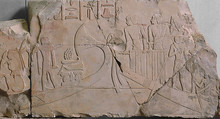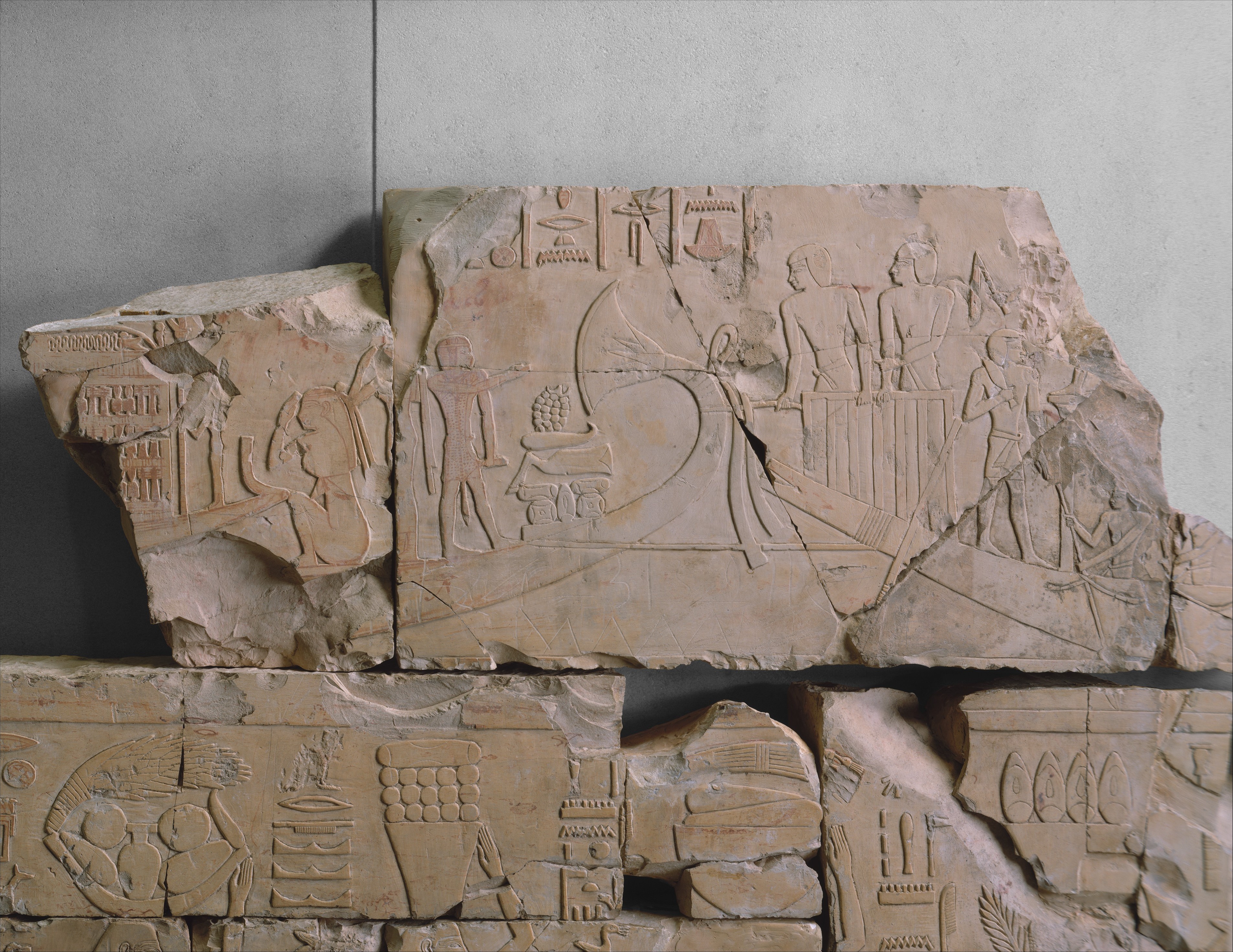Reliefs from the Tomb of Nespekashuty
Late Period, Saite
After a lapse of some three centuries in the construction of decorated tombs at Thebes, high officials of the late 25th dynasty and the 26th dynasty again built elaborate tombs in Thebes, and decorated them with fine limestone reliefs. Earlier Middle Kingdom and New Kingdom temples and tombs at Thebes offered subject matter and inflected their style. One of these impressive projects was the tomb of Nespekashuty, the vizier installed in Thebes by Psamtik I after the removal of the Kushite Dynasty by the Assyrians. First excavated by the MMA in the 1920s, recent re-clearance and conservation of the tomb have allowed a thorough study, which is forthcoming.
The vizier Nespekashuty took over the terrace of a prominent Middle Kingdom Dynasty 11 tomb cut into the north cliff at Deir el-Bahri near the Dynasty 11 temple of Mentuhotep II and the Dynasty 18 temple of Hatshepsut (see 23.3.174a). The poor stone of the cliffside was carved out to create Nespekashuty's tomb chambers and then blocks of fine dense limestone were used to line the tomb. These casing blocks eventually became brittle from fire and mostly collapsed from the walls, leaving the tomb in the crumbled state in which it was found.
The decoration
The reliefs displayed are from the west wall of Nespekashuty's tomb; along with others from this wall in the Brooklyn Museum, they focus on his funeral. In the lowest register male and female offering bearers advance to the right, and these have considerable similarities to offering bearers from Hatshepsut's Temple at Deir el-Bahri. In the second register from left to right, the barge bearing Nespekashuty's coffin and the officiating mortuary priest clad in a leopard skin is being towed across the river to the necropolis on the West Bank, preceded by boats holding gesticulating mourners. This scene is particularly influenced by 18th dynasty tombs, but is also very close in some respects to the parallel scene in the contemporary tomb of Mentuemhat, suggesting a possible relationship of the artistic teams for the two tombs.
The tomb's creators seem to have also felt a particular affinity for the manneristically elongated eyes and brows of the lively Theban 11th dynasty style.
The process of decoration
Decoration of Nespekashuty’s tomb was never completed, offering a remarkable view of the artists’ work process.
The limestone casing walls were prepared for carving by smoothing and then applying a coating of plaster that filled interstices and evened the surface. Work on the relief carving began with creating register lines by snapping ropes doused in red ocher paint against the walls. Spatters of paint around the red lines where they can still be seen result from this process. These register lines would later be drawn over. Central axis lines were drawn in to generally position figures (Drawing was in general freehand, although there are traces of a grid on the large scale figures of Nespekashuty not in this museum). Next preliminary drawings were made with a rather wide stroke brush in a comparatively faint red color. Final drawings involved modifying and defining those drawings and elaborating details with a finer darker brush. The smaller isolated relief section toward the left with only the red drawing of an offering bearer (23.3.468c) is the easiest place to observe the drawing stages, from the spatter of snapping the rope, to the red centering line for the figure, to preliminary and then final drawings.
Once this was done, relief cutting began. This, too, involved two stages for any given figure. A first pass was made by artisans who cut straight back around the outlines of the figures and cutaway background, leaving cookie-cutter shaped figures. In a second pass fine relief carvers worked on the figures, rounding the carved edges of the figures and working out their details and modeling. The stages of cutting are particularly visible in the lower left and upper right of the wall displayed.
The wall presents clues to certain aspects of the work organization. It appears the teams of relief carvers were working across a register and that at least two teams were probably working simultaneously starting at opposite ends of two adjacent registers to stay out of each other’s way. Above the bottom registers seen here the wall is even less finished, indicating the workers began at the bottom.
The long use life of the tomb
Attached to a Middle Kingdom tomb whose courtyard was reused for a Third Intermediate Period burial in the centuries before Nespekashuty's tomb was built, Nespekashuty's tomb itself saw subsequent reuse already starting from the fifth century B.C. as indicated by the written ostraka discovered there and displayed nearby. By the Ptolemaic Period, demotic and Greek texts indicate the tomb was either associated with the nearby healing temple at Deir el Bahri, or possibly was itself thought to be the shrine of a revered individual, or Hsy. On the relief wall itself above the mourners on a boat may be seen a Greek text referring to addressing the gods in shrines. And from the last known stages of the tomb's use is a block exhibited nearby that displays a drawing (23.3.761) of a Late Antique saint from the sixth-seventh centuries when the tomb was inhabited by Coptic monks or asetics.
#3525. Reliefs from the Tomb of Nespekashuty
-
3525. Reliefs from the Tomb of Nespekashuty
-
1153. Kids: Reliefs from the Tomb of Nespekashuty
Playlist
Due to rights restrictions, this image cannot be enlarged, viewed at full screen, or downloaded.
This artwork is meant to be viewed from right to left. Scroll left to view more.





